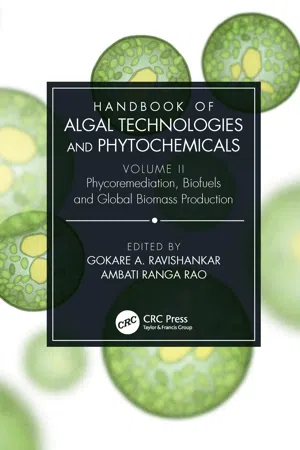
Handbook of Algal Technologies and Phytochemicals
Volume II Phycoremediation, Biofuels and Global Biomass Production
- 295 pages
- English
- ePUB (mobile friendly)
- Available on iOS & Android
Handbook of Algal Technologies and Phytochemicals
Volume II Phycoremediation, Biofuels and Global Biomass Production
About This Book
Key Features
- The most comprehensive resource available on the biodiversity of algal species, their industrial production processes and their use for human consumption in food, health and varied applications.
- Emphasis on basic and applied research, addressing aspects of scale-up for commercial exploitation for the development of novel phytochemicals (phytochemicals from algae).
- Addresses the underexplored and underutilized potential of chemicals from marine sources for health benefits.
- Each chapter, written by expert contributors from around the world, includes a Dictionary of Terms, Key Facts, Summary Points, Figures and Tables, as well as up-to-date references.
The second book in this two-volume set explores phycoremedation applications, and the sustainable use of algae for biofuels and other products of economic value. It also looks at aspects such as macro- and micro algal impact on marine ecosystem and remote sensing of algal blooms. The commercial value of chemicals of value to food and health is about $6 billion annually, of which 30 percent relates to micro and macro algal metabolites and products for health food applications. As a whole, the two volumes explore the aspects of diversity of micro and macro algal forms, their traditional uses; their constituents which are of value for food, feed, specialty chemicals, bioactive compounds for novel applications, and bioenergy molecules. Bio-business and the market share of algae-based products are also dealt with, providing global perspectives.
Frequently asked questions
Information
Section IV
Mass Production of Microalgae
15 | Open Cultivation Systems and Closed Photobioreactors for Microalgal Cultivation and Biomass Production |
Abbreviations
M | Meters |
W | Watt |
Introduction to Microalgae Cultivation System
Table of contents
- Cover
- Half-Title
- Title
- Copyright
- Dedication
- Contents
- Preface
- Acknowledgments
- Editors
- Contributors
- SECTION I Phycoremediation Applications
- SECTION II Algal Biofuels
- SECTION III Other Products of Economic Value
- SECTION IV Mass Production of Microalgae
- SECTION V Production of Algal Biomass and Products Worldwide
- Index